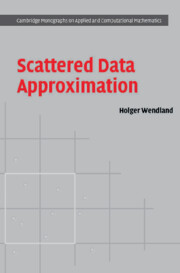Book contents
- Frontmatter
- Contents
- Preface
- 1 Applications and motivations
- 2 Haar spaces and multivariate polynomials
- 3 Local polynomial reproduction
- 4 Moving least squares
- 5 Auxiliary tools from analysis and measure theory
- 6 Positive definite functions
- 7 Completely monotone functions
- 8 Conditionally positive definite functions
- 9 Compactly supported functions
- 10 Native spaces
- 11 Error estimates for radial basis function interpolation
- 12 Stability
- 13 Optimal recovery
- 14 Data structures
- 15 Numerical methods
- 16 Generalized interpolation
- 17 Interpolation on spheres and other manifolds
- References
- Index
2 - Haar spaces and multivariate polynomials
Published online by Cambridge University Press: 22 February 2010
- Frontmatter
- Contents
- Preface
- 1 Applications and motivations
- 2 Haar spaces and multivariate polynomials
- 3 Local polynomial reproduction
- 4 Moving least squares
- 5 Auxiliary tools from analysis and measure theory
- 6 Positive definite functions
- 7 Completely monotone functions
- 8 Conditionally positive definite functions
- 9 Compactly supported functions
- 10 Native spaces
- 11 Error estimates for radial basis function interpolation
- 12 Stability
- 13 Optimal recovery
- 14 Data structures
- 15 Numerical methods
- 16 Generalized interpolation
- 17 Interpolation on spheres and other manifolds
- References
- Index
Summary
Every book on numerical analysis has a chapter on univariate polynomial interpolation. For given data sites x1 < x2 < … < xN and function values f1, …, fN, there exists exactly one polynomial pf ∈ ΦN−1(ℝ1) that interpolates the data at the data sites. One of the interesting aspects of polynomial interpolation is that the space ΦN−1(ℝ1) depends neither on the data sites nor on the function values but only on the number of points. While the latter is intuitively clear, it is quite surprising that the space can also be chosen independently of the data sites. In approximation theory the concept whereby the space is independent of the data has been generalized and we will shortly review the necessary results. Unfortunately, it will turn out that the situation is not as favorable in the multivariate case.
The Mairhuber–Curtis theorem
Motivated by the univariate polynomials we give
Definition 2.1Suppose that Ω ⊆ ℝd contains at least N points. Let V ⊆ C(Ω) be an N-dimensional linear space. Then V is called a Haar space of dimension N on Ω if for arbitrary distinct points x1, …, xN ∈ Ω and arbitrary f1, …, fN ∈ ℝ there exists exactly one function s ∈ V with s(xi) = fi, 1 ≤ i ≤ N.
- Type
- Chapter
- Information
- Scattered Data Approximation , pp. 18 - 23Publisher: Cambridge University PressPrint publication year: 2004



